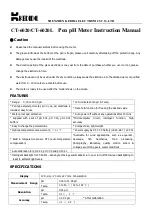
Command reference
R&S
®
ZNB/ZNBT
1459
User Manual 1173.9163.02 ─ 62
Query parameters:
<StartDate>
String containing the start date of the evaluation period
(ISO8601 format).
If you do not define a start date, the command returns data start-
ing with the data acquisition one month before the end date.
<EndDate>
String containing the end date of the evaluation period (ISO8601
format).
If you do not define a end date, the command returns data for a
month starting on the start date.
<Granularity>
Resolution of the evaluation period (default = usage over a
period of 1 day or 86 400 seconds).
You can define the resolution directly in terms of seconds as a
number or indirectly in terms of SEC, MIN, HOUR or DAY (for
example
7DAY
results in a resolution of one week). The base
unit is seconds.
Default unit: s
Return values:
<History>
<block_data>
Utilization usage of the connected instrument during the time
period you have defined. The number of return values depends
on the selected time period and time resolution. For example, if
you evaluate over a time period of one week with a resolution of
one day, the command returns 7 values.
Binary block data with the following syntax:
#<Digits><Length><Binarydata>
#
Indicates the start of the binary block.
<Digits>
Decimal value
Gives the number of decimal digits used for the
<Length>
value.
<Length>
Decimal value
Number of bytes that follow in the
<Binary data>
part.
<Binary data>
Binary data in ASCII format
The binary data represents the utilization activity. Each utilization
is assigned a timestamp for when the utilization has been active.
Together they form a pair of values.
#blockdata{"timestamps":
[<timestamp1>,<timestamp2>,...],"activity":
[<activity1>,<activity2>,...]}
Each timestamp therefore has a corresponding activity:
<timestamp1> + <activity1>, <timestamp2> +
<activity2>
HUMS and service date commands
















































